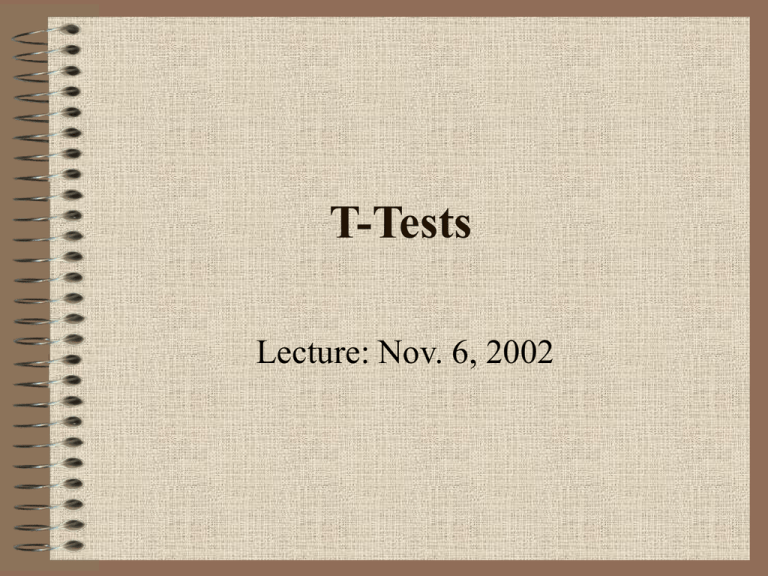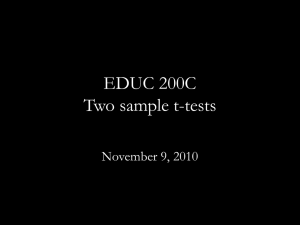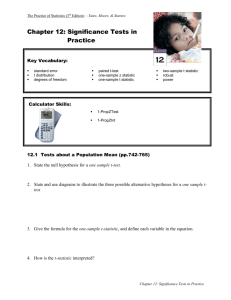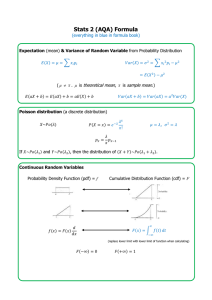Microsoft PowerPoint
advertisement

T-Tests Lecture: Nov. 6, 2002 Review • So far we have learned how to test hypothesis for two types of data: 1. Binomial data using the binomial distribution (test statistic: p) 2. Comparison of a sample mean to a known population mean and variance. (test statistic: z) T-Tests • Z-tests require that we know the population standard deviation, which is often NOT known. • In these cases, we have to use the sample variance and standard deviation, as estimates of the population variance and standard deviation. T-Tests • • • • • Population standard error (sX) = s2 / n Use sample variance (df = N – 1) Sample standard error (sX) = s2 / n This creates a new statistic, the t statistic. t = X – m / sX T-Tests • The only difference between a t-test and a z-test is the use of sample variance, not population variance in the formula. • The degrees of freedom for a t-test is N-1. • The greater the degrees of freedom (i.e., the greater the N), the more accurate the tstatistic represents the z-score. T-tests and Distributions • Each statistic has an underlying distribution. • Binomial p = binomial distribution which changes depending on p, N, and r. • z-scores = normal distribution • t-statistics = t-distribution – Changes depending on the degrees of freedom. – Larger the degrees of freedom, the more it approximates the normal distribution. T-statistics and Distributions • The t distribution is bell-shaped, but more spread out. • Greater the N, and, thus, the degrees of freedom, the less spread out the t distribution. Determining Probabilities of t • Just as you look up the probability of obtaining a z score using the unit normal table, we simply look up given t-statistic using a table for the t distribution (page 693 in textbook). • However, we must also know the degrees of freedom. Determining Probabilities of t Proportion in One Tail .05 df .025 .01 .005 Proportion in Two Tails .10 .05 .02 .01 1 6.314 12.706 31.821 63.657 2 3 4 2.920 4.303 6.965 9.925 2.353 3.182 4.541 5.841 2.132 2.776 3.747 4.604 Hypothesis Testing with the t-test Example: A researcher knows that in 1990 the average age at which 25-year-olds report having their first drink was 16. The researcher predicts that that ten years later, 25-year-olds would report a significantly younger first age of drinking. She recruits 20 25-year-olds for her study and asks when each participant had his/her first drink. Hypothesis Testing with the t-test 1. First she constructs her hypotheses. H0: mage of first drink = 16 Ha: mage of first drink = 16 Hypothesis Testing with the t-test 2. Create a decision rule. • • Set the alpha level; a = .05. Find the “critical t” in on our t-table. • • • • Because non-directional hypothesis, we must find t-value that for which that t-value or higher is < .05 using two-tails. Must look up based on 19 degrees of freedom (N – 1). This t-statistic is 2.093. So, if we get a t-statistic > 2.086, we can reject the null hypothesis. Hypothesis Testing with the t-test 3. Collect data and calculate a t-statistic. • • Assume researcher found that in her sample of 20 adults, the average age of first drink was 14, and the variance of 4. The standard error of the t-statistic. s2/n = 4/20 = .45 The t-statistic is: X – m / sX = 14-16/.45 = -2/.45 = - 4.44 Hypothesis Testing with the t-test 4. Apply the decision rule. – – – – – Is our obtained t-statistic equal to or larger than our “critical t”? Obtained t: -4.44 Critical t: 2.093 The absolute value of our t-statistic is more extreme. In other words, there is less than a 5% probability that if the population mean is 16 that we would obtain a sample mean of 14 with a variance of 4. Reject the null hypothesis; accept the alternative hypothesis. Assumptions of the t-test 1. All observations must be independent. 2. The population distribution of scores must be normally distributed. Reporting a t-test • When reporting a t-statistic you should provide the sample mean and sample standard deviation somewhere in the paper. • You should also report the t-statistic, the degrees of freedom, whether it fell within the region of rejection, and whether it was a one- or two-tailed test. Reporting a t-test Example: The 20 participants reported the age at which they had their first drink (M = 14, SD = 2). This age was significantly different from the average age of 16 reported a decade earlier, t(19) = -4.44, p < .05, two-tailed.





